The Chemistry of Love
As we progress through the month of February, Valentine’s Day is coming up very quickly. Love is known as a universal language, therefore it wouldn’t be surprising seeing it all around the world on February 14. Though this day is mostly for couples, everyone has experienced moments of love. While many have felt and experienced it, very few truly understand how they feel the sensation of love. So how does chemistry explain one of the strongest emotions humans possess?
What is Love?
Love is the feeling of intense affection, appreciation, and fondness of someone or something. You can love people, objects, and ideas; you can feel love towards almost anything. Everyone shows love differently, but there are many commonalities people share when expressing love. Towards others, people might feel a sense of joy and happiness, a willingness to put people they love before themselves, or a sense of sacrifice they wouldn’t do for just anyone. People might also experience a deep sense of care, positivity, and commitment. Physical effects can be shown as nervousness (that feeling of butterflies in the stomach), a spinning head, flushed cheeks, a fast-beating heart, etc. Towards objects or ideas, people may feel a strong sense of passion or enjoyment towards that thing. For example, someone might enjoy spending time on a particular hobby and working hard to improve upon it. So, love is not just a descriptive word for a feeling. It can come in many forms and be described in many different ways, and it is all around us.
How Does Love Tie in with Science?
Now, many may wonder: How much does love have to do with science? The answer: A lot. In fact, the chemistry behind love unpacks all the answers of how and why people feel what they feel. In the eyes of neurologists and chemists, love is more than just a mere feeling. Truthfully, it is the occurrence of chemicals and chemical reactions that first begins in the brain thanks to five particular neurochemicals – dopamine, norepinephrine, phenylethylamine, oxytocin, and serotonin.
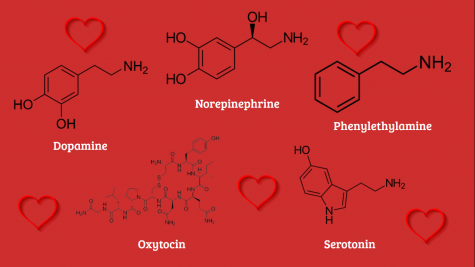
To start things off, dopamine is a neurotransmitter responsible for the “feel good” sense of love. Things that make people happy differ, but activities such as eating comfort foods, exercising, or listening to a favorite song are common “feel good” actions amongst people that stimulate dopamine. As a neurotransmitter in the brain, dopamine activates five or more receptors in the brain that are associated with a person’s pleasure system. This includes elevated feelings of happiness, enjoyment, and motivation, all of which encourage positive and productive behavior. Productive behavior is also linked to dopamine’s “reward system.” Dopamine enhances reward-related memories/the expectation of reward that powerfully influences strong emotions and reactions. Within regions of the brain that are linked to the release of dopamine, significant effects on brain processes and activity occur. These range from emotional responses to the ability to express pleasure or pain. Dopamine is the main cause of why people tend to become more talkative, passionate, sociable, or excitable when they are near people or things they love.
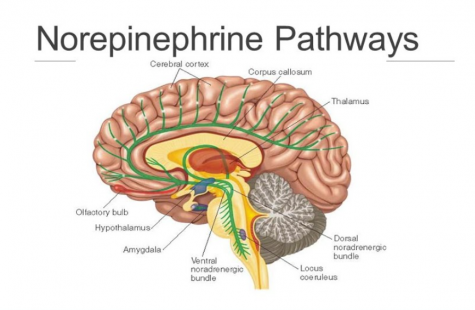
Along with dopamine, norepinephrine, another neurotransmitter, is responsible for inducing adrenaline, hence another common name norepinephrine is known by, noradrenaline. To activate some of the feelings associated with love, norepinephrine is released from nerve cells in the brain in the form of noradrenergic neurons. These neurons connect together to create the norepinephrine system, which when triggered, affects large parts of the brain. The effects of norepinephrine are exerted when the hormone binds to main target cells along the spinal cord, thalamus, and neocortex (cells in other locations can be binded to but these are the main three areas where norepinephrine chooses to bind) and activates the cells’ adrenergic receptors. When activated, adrenaline, a hormone released and activated in the body when a person is feeling extreme emotions (such as love) and causes an increase in energy, floods the brain. Its common “side effects” become physically visible, shown as sweaty palms, a racing heart, loss in appetite, increased experiences of joy, and rosy cheeks. However, all of these physical effects of norepinephrine occur thanks to dopamine, norepinephrine’s precursor. Without dopamine, norepinephrine’s effects would not happen.
Aside from dopamine and norepinephrine, phenylethylamine (PEA) is not a neurotransmitter, but a neuromodulator that increases extracellular levels of dopamine and modulates noradrenergic transmission. Along with enhancing the actions of dopamine and norepinephrine, PEA is also categorized as a natural stimulant, behaving similarly to amphetamines that help to stimulate the production of endorphins. Thus, large quantities of PEA lead to and increase in physical and emotional energy. High levels of PEA are released in the brain mostly when a person is first attracted to someone. This chemical is responsible for the dizzy feelings and “butterflies” associated with love, explaining a nickname it is commonly known by, the molecule of love.
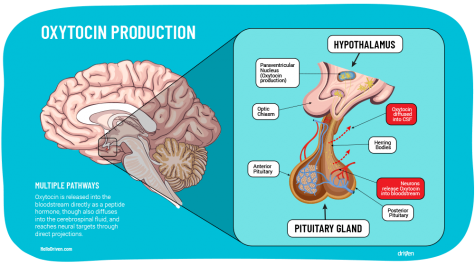
Oxytocin, a hormone that acts as a neurotransmitter, plays a large role in love. Oxytocin’s main function is being a source of attachment, which is the predominant factor in long-term relationships. For example, a study in 2012 found that people in the first stages of romantic attachment had higher levels of oxytocin, compared to non-attached single people. Attachment also helps to “mediate friendships, parent-infant bonding, social cordiality, and many other intimacies.” Oxytocin, which is produced by the hypothalamus and released by the pituitary gland, acts on many systems within the brain. Oxytocin receptors are also present within numerous areas of the brain associated with romantic love. However, the main area of the brain that oxytocin interacts with is the dopaminergic reward system – oxytocin can stimulate the release of dopamine from the hypothalamus. Oxytocin is frequently released when people snuggle or bond socially, and because of this, it is nicknamed the “cuddle hormone” or even the “love hormone.” Oxytocin has other functions besides attachment and love. It has social functions, like impacting bonding behavior, the creation of group memories, and social recognition. The hormone also contributes to relaxation, trust, and physiological stability through its impact on “pro-social behaviors” and emotional responses. Men and women are both influenced by oxytocin, but women tend to be more sensitive to the hormone.
Finally, serotonin is known as the “happy hormone.” It is the key hormone that stabilizes mood, feelings of well-being, and happiness. By enabling brain cells and other cells within the nervous system to communicate with each other, serotonin affects the entire body. Serotonin also affects digestion, nausea, sleep, blood clotting, and bone health. Too little serotonin can lead to depression, but too much serotonin can create excessive nerve cell activity. While it may not necessarily play a role in creating love, levels of serotonin increase when people are attracted to others or when they are around loved ones.
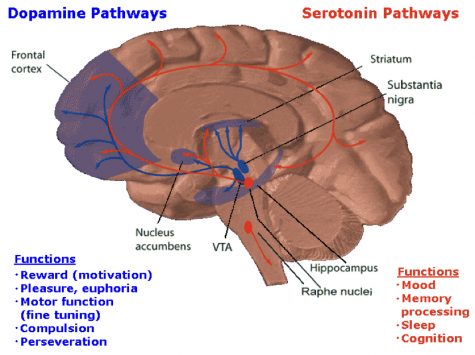
How Does Everything Come Together?
When these five neurotransmitters and hormones come together, they create the “perfect storm” we call love. Dopamine creates the “feel good” sense of love and feelings of happiness, enjoyment, and motivation, as well as enhancing reward-related memories. When people experience extreme emotions, norepinephrine creates a rush of adrenaline, which leads to a surge of energy, a racing heart, increased experiences of joy, and rosy cheeks. Phenylethylamine, also known as the molecule of love, is most known for creating dizzying and weak stomach sensations, which also enhance the production of dopamine and norepinephrine. Oxytocin, commonly called the “cuddle hormone,” creates a feeling of attachment, impacts relaxation and trust, and also has social functions (like impacting bonding behavior and social recognition). Serotonin, the “happy hormone,” creates feelings of well-being and happiness and increases when people are around others they are attracted to. Together, these five neurochemicals and their reactions in the body explain why love is so emphatic, passionate, and exciting!


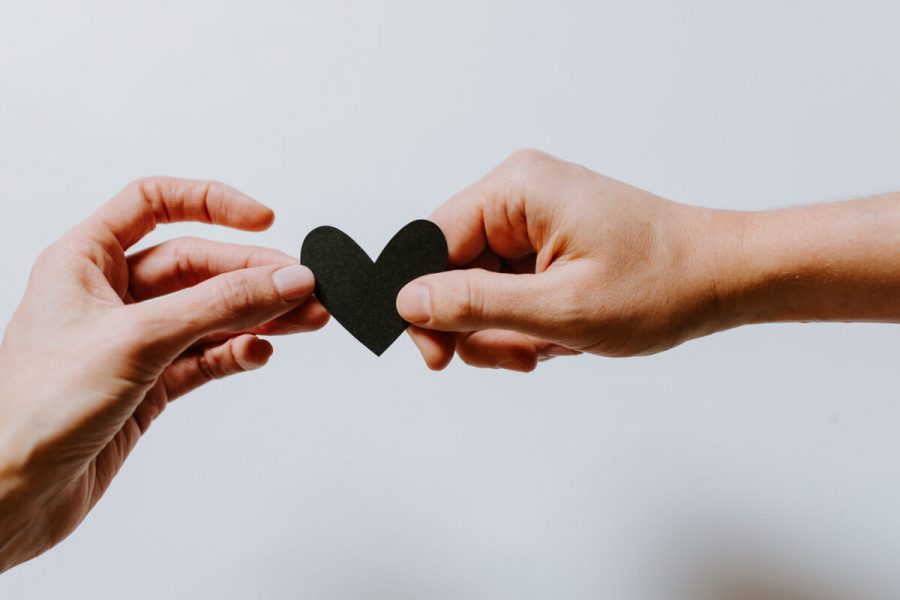
Samruddhi Palve • Mar 5, 2021 at 12:11 pm
Great article – I loved it!! Super comprehensible but still detailed – Fantastic job, Karina + Sophie!!